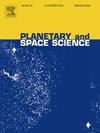微波加热作为一种ISRU提取技术对不同排列方式的月球冰冻层的有效性
IF 1.7
4区 物理与天体物理
Q3 ASTRONOMY & ASTROPHYSICS
引用次数: 0
摘要
月球两极可能含有大量的水冰。水冰之所以引起人们的兴趣,是因为它能够回答有关太阳系水库的科学问题,以及它作为创建可持续地月经济的可用空间资源的潜力。月球极地水冰存在于极端恶劣的真空条件下,温度低至40 K。因此,寻找提取这种水冰的最有效技术是确定月球水是否适合作为经济上可行的空间资源的一个重要方面。在前人工作的基础上,本研究探讨了月球极地环境中不同可能的冰层排列方式对微波加热作为水提取技术适用性的影响。创建了三种冰表土类似物的排列:永久冻土,细颗粒和粗颗粒。样品的质量为40克,使用月球高地模拟物LHS-1,目标含水量为5 wt %。样品在微波加热装置中以250 W, 2.45 GHz的微波能量处理60 min,通过实时测量微波加热过程中样品质量的变化以及加热前后样品质量的变化来确定水的提取量。多年冻土、细颗粒和粗颗粒样品的提取率分别为92%、83%和97%。对在各个样品的质量损失剖面中观察到的变化提供了可能的解释,包括对不同冰形态(永久冻土和粒状)的样品之间的差异以及不同冰表面积(细颗粒和粗颗粒)的样品之间的差异的解释。虽然观察到差异,但微波加热有效地提取了所有样品中的水,并且仍然是ISRU从冰冷的月球风化层中提取水的有效技术。不同冰性风化层的水萃取差异可以用于确定埋地样品中冰的排列。本文章由计算机程序翻译,如有差异,请以英文原文为准。
The effectiveness of microwave heating as an ISRU extraction technique on different arrangements of icy lunar regolith
The lunar poles potentially contain vast quantities of water ice. The water ice is of interest due to its capability to answer scientific questions regarding the Solar System's water reservoir and its potential as a useable space resource for the creation of a sustainable cislunar economy. The lunar polar water ice exists in extremely harsh conditions under vacuum at temperatures as low as 40 K. Therefore, finding the most effective technique for extracting this water ice is an important aspect of ascertaining the suitability of lunar water as an economically viable space resource. Based on previous work, this study investigates the impact of the different possible arrangements of icy regolith in the lunar polar environment on the suitability of microwave heating as a water extraction technique. Three arrangements of icy regolith analogues were created: permafrost, fine granular, and coarse granular. The samples were created to a mass of 40 g, using the lunar highlands simulant LHS-1, and a target water content of 5 wt %. The samples were processed in a microwave heating unit using 250 W, 2.45 GHz microwave energy for 60 min. The quantity of water extracted was determined by measuring the sample mass change in real-time during microwave heating and the sample mass before and after heating. The permafrost, fine granular, and coarse granular samples had extraction ratios of 92 %, 83 %, and 97 %, respectively. Possible explanations for the observed variations seen in the mass loss profiles of the respective samples are provided, including explanations for the differences between samples of varying ice morphology (permafrost and granular) and the differences between samples with varying ice surface areas (fine and coarse granular). While differences were observed, microwave heating effectively extracted water in all the samples and remains an effective ISRU technique for extracting water from icy lunar regolith. Differences in the water extraction of different icy regolith could be useful in determining the arrangement of ice in buried samples.
求助全文
通过发布文献求助,成功后即可免费获取论文全文。
去求助
来源期刊

Planetary and Space Science
地学天文-天文与天体物理
CiteScore
5.40
自引率
4.20%
发文量
126
审稿时长
15 weeks
期刊介绍:
Planetary and Space Science publishes original articles as well as short communications (letters). Ground-based and space-borne instrumentation and laboratory simulation of solar system processes are included. The following fields of planetary and solar system research are covered:
• Celestial mechanics, including dynamical evolution of the solar system, gravitational captures and resonances, relativistic effects, tracking and dynamics
• Cosmochemistry and origin, including all aspects of the formation and initial physical and chemical evolution of the solar system
• Terrestrial planets and satellites, including the physics of the interiors, geology and morphology of the surfaces, tectonics, mineralogy and dating
• Outer planets and satellites, including formation and evolution, remote sensing at all wavelengths and in situ measurements
• Planetary atmospheres, including formation and evolution, circulation and meteorology, boundary layers, remote sensing and laboratory simulation
• Planetary magnetospheres and ionospheres, including origin of magnetic fields, magnetospheric plasma and radiation belts, and their interaction with the sun, the solar wind and satellites
• Small bodies, dust and rings, including asteroids, comets and zodiacal light and their interaction with the solar radiation and the solar wind
• Exobiology, including origin of life, detection of planetary ecosystems and pre-biological phenomena in the solar system and laboratory simulations
• Extrasolar systems, including the detection and/or the detectability of exoplanets and planetary systems, their formation and evolution, the physical and chemical properties of the exoplanets
• History of planetary and space research
 求助内容:
求助内容: 应助结果提醒方式:
应助结果提醒方式:


